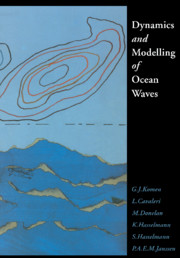Book contents
- Frontmatter
- Contents
- Contributors
- Preface
- Chapter I Basics
- Chapter II The physical description of wave evolution
- Chapter III Numerical modelling of wave evolution
- Chapter IV Applications to wave hindcasting and forecasting
- Chapter V Global satellite wave measurements
- Chapter VI Wave data assimilation and inverse modelling
- Chapter VII Summary and outlook
- Members of the WAM group
- Affiliations and addresses of contributors
- Notation and abbreviations
- References
- Index
Chapter I - Basics
Published online by Cambridge University Press: 22 January 2010
- Frontmatter
- Contents
- Contributors
- Preface
- Chapter I Basics
- Chapter II The physical description of wave evolution
- Chapter III Numerical modelling of wave evolution
- Chapter IV Applications to wave hindcasting and forecasting
- Chapter V Global satellite wave measurements
- Chapter VI Wave data assimilation and inverse modelling
- Chapter VII Summary and outlook
- Members of the WAM group
- Affiliations and addresses of contributors
- Notation and abbreviations
- References
- Index
Summary
Wave modelling in historical perspective
The third generation ocean wave models considered in this book are numerical models which integrate the dynamical equations that describe the evolution of a wave field. Their development followed progress in understanding ocean wave dynamics and experience with practical forecasting methods.
The study of ocean wave dynamics has a very long history indeed. Khandekar (1989) quotes Aristotle, Pliny the Elder, Leonardo da Vinci and Benjamin Franklin. In Phillips (1977) it is recalled how Lagrange, Airy, Stokes and Rayleigh, the ‘nineteenth century pioneers of modern theoretical fluid dynamics’, sought to account for the properties of surface waves. Subsequent progress in the twentieth century has been enormous, as any reader of, for instance, the Journal of Fluid Mechanics will realize. The subject has grown so large that it is nearly impossible for one person to have a comprehensive knowledge of all aspects. There are a number of useful textbooks, devoted totally or in part to water waves (Krauss, 1973, Whitham, 1974, Phillips, 1977 and LeBlond and Mysak, 1978, for example). Subjects that are of special relevance to wave modelling are the propagation of waves, their generation by wind, their nonlinear properties, their dissipation and their statistical description. We will discuss all these aspects in later sections where we will also indicate the historical perspective. Here it is enough to recall the milestones formed by the theoretical work of Phillips and Miles on wave generation and by Hasselmann's theory of four wave interactions.
Information
- Type
- Chapter
- Information
- Dynamics and Modelling of Ocean Waves , pp. 1 - 68Publisher: Cambridge University PressPrint publication year: 1994
